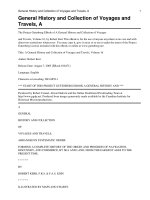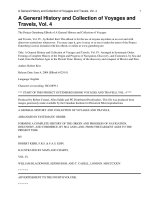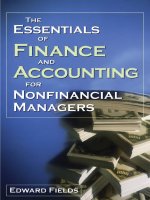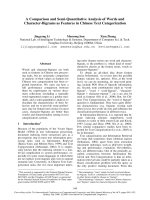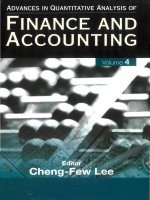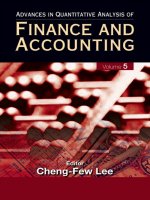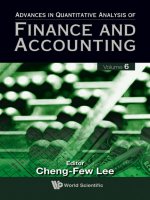ADVANCES IN QUANTITATIVE ANALYSIS OF FINANCE AND ACCOUNTING Volume 4 doc
Bạn đang xem bản rút gọn của tài liệu. Xem và tải ngay bản đầy đủ của tài liệu tại đây (16.55 MB, 376 trang )
ADVANCES IN QUANTITATIVE ANALYSIS OF
FINANCE AND
ACCOUNTING
Volume 4
dito
Cheng-Fe
ADVANCES IN QUANTITATIVE ANALYSIS OF
FINANCE AND
ACCOUNTING
Advances in Quantitative Analysis of Finance and Accounting
Editorial Board
Cheng F. Lee
Mike J. Alderson
James S. Ang
K. R. Balachandran
Thomas C. Chiang
Thomas W. Epps
Thomas J. Frecka
Robert R. Grauer
Puneet Handa
Der-An Hsu
Prem C. Jain
Jevons C. Lee
Wayne Y. Lee
Scott C. Linn
Gerald J. Lobo
Yaw Mensah
Thomas H. Noe
Oded Palmon
Louis O. Scott
Andrew J. Senchak
David Smith
K. C. John Wei
William W.S.Wei
Chunchi Wu
Uzi Yaari
Rutgers University, USA
University of St. Louis, USA
Florida State University, USA
New York University, USA
Drexel University, USA
University of Virginia, USA
University of Notre Dame, USA
Simon Fraser University, Canada
University of Iowa, USA
University of Wisconsin, Milwaukee, USA
Georgetown University, USA
Tulane University, USA
Kent State University, USA
University of Oklahoma, USA
University of Houston, USA
Rutgers University, USA
Tulane University, USA
Rutgers University, USA
Morgan Stanley Dean Witter, USA
University of
Texas,
Austin, USA
Iowa State University, USA
Hong Kong Technical University, Hong Kong
Temple University, USA
Syracuse University, USA
Rutgers University, USA
ADVANCES IN QUANTITATIVE ANALYSIS OF
FINANCE AND
ACCOUNTING
Editor
Cheng-Few Lee
Rutgers University, USA
YJ?
World
Scientific
NEW JERSEY • LONDON • SINGAPORE • BEIJING • SHANGHAI • HONG KONG • TAIPEI • CHENNAI
Published by
World Scientific Publishing Co. Pte. Ltd.
5 Toh Tuck Link, Singapore 596224
USA office: 27 Warren Street, Suite 401-402, Hackensack, NJ 07601
UK office: 57 Shelton Street, Covent Garden, London WC2H 9HE
British Library Cataloguing-in-Publication Data
A catalogue record for this book is available from the British Library.
ADVANCES IN QUANTITATIVE ANALYSIS OF FINANCE AND ACCOUNTING
Advances in Quantitative Analysis of Finance and Accounting — Vol. 4
Copyright © 2006 by World Scientific Publishing Co. Pte. Ltd.
All rights
reserved.
This
book,
or parts
thereof,
may not be reproduced in any form or by any means,
electronic or
mechanical,
including
photocopying, recording or any information storage and retrieval
system now known or to be
invented,
without written permission from the Publisher.
For photocopying of material in this volume, please pay a copying fee through the Copyright
Clearance Center, Inc., 222 Rosewood Drive, Danvers, MA 01923, USA. In this case permission to
photocopy is not required from the publisher.
ISBN 981-270-021-8
Typeset by Stallion Press
Email:
Printed in Singapore by World Scientific Printers (S) Pte Ltd
Preface to Volume 4
Advances in Quantitative Analysis of Finance and Accounting is an annual
publication designed to disseminate developments in the quantitative analy-
sis of finance and accounting. The publication is a forum for statistical and
quantitative analyses of issues in finance and accounting as well as applica-
tions of quantitative methods to problems in financial management, financial
accounting, and business management. The objective is to promote interaction
between academic research in finance and accounting and applied research in
the financial community and the accounting profession.
The papers in this volume cover a wide range of
topics,
including earnings
management, management compensation, option theory and application, debt
management and interest rate theory, and portfolio diversification.
In this volume, there are 14 papers, seven of them apply accounting
information to earnings management and management compensation: 1. Firm
Performance and Compensation-Based Stock Trading by Corporate Execu-
tives; 2. Management Compensation, Debt Contract, and Earnings Manage-
ment
Strategy;
3. Estimated Operating Cash
Flow,
Reported Cash Flow from
Operating Activities, and Financial Distress; 4. Earnings Surprise and the
Relative Information Content of Short Interest; 5. Group Types and Earn-
ings Management; 6. The
Tendency
of Firm Managers
to
Avoid Small Losses;
7. Beating or Meeting Earnings-Based
Target
Performance in CEOs' Annual
Cash Bonuses.
Two of the remaining seven papers are related to option theory and appli-
cation:
1.
Real
Option
Based Equity
Valuation
Models: An Empirical Analysis;
2.
The Shift Function for the Extended
Vasicek
Model.
Three of the remaining
five papers are related to debt management and interest rate theory: I. Risky
Debt-Maturity Choice under Information Asymmetry;
2.
A
Bayesian
Approach
for
Testing
the Debt Signaling Hypothesis in a Transitional Market: Perspec-
tives
from Egypt; 3. Taking Positive Interest Rates Seriously. The remaining
two papers are related
to
portfolio diversification:
1.
Do
Winners Perform
Better
Than
Losers? A Stochastic Dominance Approach;
2.
Corporate
Diversification
and the Price-Earnings Association.
Preface to Volume 4 v
List of Contributors ix
Chapter
1
Real Option Based Equity
Valuation
Models:
An Empirical Analysis 1
A. William Richardson, Raafat R. Roubi,
Hemantha S. B. Herath
Chapter 2 Firm Performance and Compensation-Based Stock
Trading
by Corporate Executives 37
Zahid Iqbal
Chapter 3 Management Compensation, Debt
Contract,
and
Earnings Management Strategy 59
Chia-Ling Lee, Victor
W.
Liu
Chapter 4 Risky Debt-Maturity Choice under Information
Asymmetry 75
Sheen Liu, Chunchi Wu
Chapter 5 Estimated Operating Cash
Flow,
Reported Cash Flow
from
Operating
Activities, and Financial Distress 97
Terry J. Ward, Benjamin
P.
Foster, Jon Woodroof
Chapter 6 Earnings Surprise and the Relative Information
Content of Short Interest 121
Jose Mercado-Mendez, Roger J. Best, Ronald
W.
Best
Chapter 7 Group Types and Earnings Management 137
Min-Jeng Shiue, Chan-Jane Lin, Chi-Chun Liu
viii Contents
Chapter 8 A Bayesian Approach for
Testing
the Debt Signaling
Hypothesis in a
Transitional
Market:
Perspectives
from Egypt 163
Tarek I. Eldomiaty, Mohamed
A.
Ismail
Chapter 9 The
Tendency
of Firm Managers
to
Avoid Small Losses 195
Yi-Tsung Lee, Ging-Ginq Pan
Chapter 10 Do
Winners
Perform Better Than Losers? A Stochastic
Dominance Approach 219
Wing-Keung Wong, Howard E. Thompson,
Steven X.
Wei,
Ying-Foon Chow
Chapter 11 The Shift Function for the Extended
Vasicek
Model 255
Shyan Yuan Lee, Cheng Hsi Hsieh
Chapter 12 Beating or Meeting Earnings-Based
Target
Performance
in CEOs' Annual Cash Bonuses 271
Simon S. M. Yang
Chapter 13 Corporate Diversification and the Price-Earnings
Association 299
Ben-Hsien Bao, Da-Hsien Bao
Chapter 14
Taking Positive
Interest Rates Seriously 327
Enlin Pan, Liuren Wu
Index
357
List of Contributors
Chapter 1
A.
William Richardson
DeGroote School of Business
McMaster University
1280 Main Street
Hamilton, Ontario L8S 4M4, Canada
Tel:
905-525-9140 Ext. 23993
Fax: 905-521-8995
Email:
Raafat R. Roubi
Department of Accounting
Brock University
Faculty of Business, Taro Hall 225
500 Glenridge Avenue
St. Catharines, Ontario L2S 3A1, Canada
Tel.:
905-688-5550 Ext. 4186
Fax: 905-688-9779
Email:
Hemantha S. B. Herath
Department of Accounting
Brock University
Faculty of Business, Taro Hall 240
500 Glenridge Avenue
St. Catharines, Ontario L2S 3A1, Canada
Tel:
905-688-5550 Ext. 3519
Fax: 905-688-9779
Email:
IX
x
List
of Contributors
Chapter 2
Zahid Iqbal
School of Business
Texas Southern University
Houston, TX 77004
Tel.:
713-313-7737
Fax: 713-313-7722
Email:
Chapter 3
Chia-Ling Lee
Department of Accounting and Information Technology
National Chung Cheng University
168 University Rd., Min-Hsiung
Chia-Yi 621
Taiwan, R.O.C.
Tel:
886-5-2720411 Ext. 34502
Fax:886-5-2721197
Email:
Victor W. Liu
Department of Business Management
National Sun Yat-sen University
70 Lien-hai Rd.
Kaohsiung 804, Taiwan, R.O.C.
Tel.:
886-7-5254661
Fax: 886-7-5254662
Email:
Chapter 4
Sheen Liu
Williamson College of Business Administration
Youngstown State University
Youngstown, OH 44504, USA
Tel.:
330-941-7149
Fax: 330-941-1459
Email:
Chunchi Wu
Lee Kong Chian School of Business
Singapore Management University
Singapore 178899
Tel.:
65-6828-0158
Fax: 65-6828-0427
Email:
Chapter 5
Terry J. Ward
Department of Accounting
PO Box 50
Middle Tennessee State University
Murfreesboro, TN 37132, USA
Tel.:
615-898-2341
Fax: 615-898-5839
Email:
Benjamin P. Foster
University of Louisville, USA
Tel.:
502-852-4826
Email: bpfostOl @gwise.louisville.edu
Jon Woodroof
The University of Tennessee, USA
Tel:
865-974-1762
Email:
Chapter 6
Jose Mercado-Mendez
Department of Economics and Finance
Central Missouri State University
Warrensburg, MO 64093, USA
Tel.:
660-543-8650
Email:
xii List of
Contributors
Roger J. Best
Department of Economics and Finance
Central Missouri State University
Warrensburg, MO 64093, USA
Tel.:
660-543-4246
Email:
Ronald W. Best
Department of Accounting and Finance
University of West Georgia
Carrollton, GA 30118, USA
Tel.:
678-839-4812
Email:
Chapter 7
Min-Jeng Shiue
Department of Accounting
National Taipei University, Taiwan
Tel:
886-2-2502-4654 Ext. 18412
Fax: 886-2-2506-0730
Email:
Chan-Jane Lin
Department of Accounting
National Taiwan University
1 Roosevelt Rd. Sec. 4
Taipei, Taiwan 106
Tel:
886-2-3366-1115
Fax: 886-2-2363-3640
Email:
Chi-Chun Liu
Department of Accounting
National Taiwan University, Taiwan
Tel.:
886-2-3366-1119
Fax: 886-2-2363-8038
Email:
List of Contributors xiii
Chapter 8
Tarek I. Eldomiaty
United Arab Emirates University
P.O.
Box 17555, UAE
Tel.:
9713-7133405
Fax: 9713-7624384
Email:
Mohamed A. Ismail
United Arab Emirates University
P.O.
Box 17555, UAE
Tel.:
9713-7133342
Fax: 9713-7622944
Email:
Chapter 9
Yi-Tsung Lee
Department of Accounting
National Chengchi University
64,
Tz-nan Rd., Sec. 2, Wenshan
Taipei 11623, Taiwan, R.O.C.
Tel:
886-2-29393091 Ext. 81027
Fax:886-2-29387113
Email:
Ging-Ginq Pan
Graduate Institute of Finance
National Pingtung University of Science and Technology
1,
Hseuh Fu Road, Neipu Hsiang
Pingtung, Taiwan, R.O.C.
Tel.:
886-8-7703202 Ext. 7818
Fax: 886-8-7703202 Ext. 7833
Email:
xiv List of
Contributors
Chapter 10
Wing-Keung Wong
Department of Economics
National University of Singapore
1 Arts Link, Singapore 117570
Tel:
65-6874-6014
Fax: 65-6775-2646
Email:
Howard E. Thompson
Department of Finance, Investment and Banking
University of Wisconsin-Madison
975 University Avenue
Madison, WI 53706, USA
Tel:
608-831-2456
Fax: 608-262-6378
Email:
Steven X. Wei
School of Accounting and Finance
The Hong Kong Polytechnic University
Hung Horn, Hong Kong
Tel.:
852-2766-7056
Fax: 852-2330-9845
Email:
Ying-Foon Chow
Department of Finance
Chinese University of Hong Kong
Shatin, New Territories
Hong Kong
Tel.:
852-2609-7638
Fax: 852-2603-6586
Email:
Chapter 11
Shyan Yuan Lee
Department of Finance
National Taiwan University
Room 1012, 10F, 50, Sec. 4, Keelung Rd.
106,
Taipei, Taiwan
Tel:
886-2-2362-1845
Fax: 886-2-2362-1845
Email:
Cheng Hsi Hsieh
Department of Finance
National Taipei College of Business
321,
Sec. 1, Jinan Rd.
Jungjeng Chiu, 100, Taipei, Taiwan
Tel.:
886-2-2916-2133
Fax: 886-2-2232-6378
Email:
Chapter 12
Simon S. M. Yang
School of Business, Adelphi University
One South Avenue
Garden City, NY 11530, USA
Tel:
516-877-4618
Fax: 516-877-4607
Email:
Chapter 13
Ben-Hsien Bao
School of Accounting and Finance
Hong Kong Polytechnic University, Hong Kong
Tel.:
852-2766-7078
Email:
xvi List of Contributors
Da-Hsien Bao
Accounting and Finance Department
College of Business
Rowan University
New Jersey, USA
Tel:
856-256-4500 Ext. 3031
Email:
Chapter 14
Enlin Pan
Chicago Partners, LLC
123 N Waukegan Road, Suite 207
Lake
Bluff,
IL 60044, USA
Tel:
847-863-4747
Email:
Liuren Wu
Zicklin School of Business
Baruch College
One Bernard Baruch Way
Box B10-225
New
York,
NY 10010, USA
Tel.:
646-312-3509
Fax: 646-312-3451
Email:
Chapter 1
Real Option Based Equity Valuation Models: An
Empirical Analysis
A. William Richardson
McMaster
University,
Canada
Raafat R. Roubi and Hemantha S. B. Herath
Brock
University,
Canada
This paper provides empirical evidence in support of real option based equity valuation models
that relate share price to accounting earnings and book
value.
Our empirical results are generally
consistent with the predictions of several models, all of which are based on real options theory.
However, we find that the basic model, which includes components related to put and call
options, fits the data more efficiently and parsimoniously than do models modified for the
level of firm efficiency (i.e., accounting profitability measured as the return on common equity
book value). We also find that the fit of the basic model and the derived coefficients vary with
firm efficiency as measured by accounting profitability. We also test for the impact of capital
structure on equity valuation and find some evidence for the relevance of debt for loss firms
(i.e.,
low efficiency firms) and growth firms. We find anomalous results for loss firms, consistent
with previous research, and provide an explanation for them. Our research contributes to the
valuation literature by studying the empirical validity of a general real option based model and
thus extends previous empirical studies that were based more or less on an options approach.
Our contribution is significant in that there have been many theoretical papers on real options,
but few empirical studies of the predictions of these models.
Keywords: Real options; valuation; equity valuation; clean surplus.
1.
Introduction
The valuation of equity securities is of fundamental importance in accounting
and finance, and has been the subject of theoretical and empirical study over
many years. There have been a considerable number of papers that have exam-
ined
the
relationship between the market value of equity and various accounting
numbers reported in the financial statements. For example, Landsman (1986),
Barth (1991), and Shevlin (1991) examine the role of balance sheet measures in
equity valuation. Other studies such as Ball and Brown (1968), Barth, Beaver,
and Landsman (1992), Collins and Kothari (1989), and Collins, Maydew, and
Weiss (1997) examine an alternative income statement approach to equity
valuation based on earnings. In a more complete framework, Ohlson (1995)
l
2 A.
William
Richardson, Raafat
R.
Roubi & Hemantha S. B. Herath
and Feltham and Ohlson (1995) combine the two approaches and show that,
under a certain reasonable set of assumptions, a firm's value can be modeled as
a function of both the book value of equity and the level of earnings.
Although considerable progress has been made, there remain some funda-
mental questions that have still not been completely resolved. These include
(1) the real option fraction of equity value to expand or contract the scale of
operations; (2) financial implications of measures such as dividend payout,
capital structure, and capital expenditure (Rees, 1997); and (3) to a lesser
extent, the negative price-earnings anomaly observed for loss firms in the cur-
rent paper and in Jan and Ou (1995), Burgstahler and Dichev (1997), and
Kothari and Zimmerman (1995). Collins, Pincus, and Xie (1999) provide a
reasonable explanation and suggest adding the book value of equity to the
simple earnings model.
In his seminal paper, Myers (1977) conceptualized the idea of viewing a
firm's growth opportunities as real options. He provides the theoretical frame-
work to value a firm as income generating assets-in-place plus the value of
growth opportunities arising from future discretionary investments. Although
there has been extensive research on theoretical real option models and appli-
cations since Myers' (1977) article, there have been only a few empirical
studies in the real options literature. More specifically, Paddock, Siegel, and
Smith (1988), Bailey (1991), Quigg (1993), and Moel and Tufano (2002) com-
pare the net present value (NPV) with real options models. McConnell and
Muscarella (1985) investigate market reaction to positive NPV projects, and
Belkaoui (2000) uses a general regression model with corporate reputation,
multinationality, size, profitability, leverage, and systematic risk as variables
to estimate growth opportunities. In addition, Burgstahler and Dichev (1997)
include an adaptation option (i.e., the value of the option to convert a firm's
resources to more productive alternatives) in an equity valuation model and
Berger, Ofek, and Swary (1996) consider an abandonment option.
The basic purpose of this paper is to extend our knowledge of the rela-
tionship of accounting numbers, specifically book value and earnings, to the
market value of equity using real option based valuation models. Following
Zhang (2000), this empirical study tests the predictions of a number of val-
uation models derived by supplementing standard valuation models with real
options theory. We run regressions of the various valuation models for our
full sample and several sub-samples stratified based on profitability levels. We
show that the predictions of the various models hold generally for our sample
Real Option Based Equity
Valuation
Models 3
but that Zhang's (2000) basic valuation model seems superior to his modified
models. Because of apparent empirical anomalies in some situations, we have
examined the assumptions and predictions of the real option based models
more closely. In addition, we consider the financial implications of capital
structure by modifying the operational version of Zhang's (2000) basic model
to test the value relevance of debt for our sample stratified on profitability.
Finally, we show that, although a sub-sample of firms' (i.e., loss firms) coeffi-
cients have a negative sign, our empirical findings are not anomalous but rather
quite consistent with the more detailed expectations from the model.
The current paper makes several contributions to the valuation literature.
First, it provides empirical evidence to support theoretical results based on real
options theory. Prior empirical findings are based on the earnings capitalization
model and the more complete, but intuitive, valuation models that include earn-
ings and book value as explanatory variables. This contribution is significant
since there have been few empirical studies that have tested predictions rooted
in real options theory. Second, we incorporate capital structure considerations
that are ignored in Zhang's (2000) basic model and discuss the value relevance
of debt in equity valuation for cross-sectional stratified sub-samples. Third,
despite apparent anomalies, our empirical results are consistent with those of
previous research and provide further evidence on the variability of coefficients
in valuation models and suggest that Collins, Pincus, and Xie's (1999) warning
on the interpretation of the coefficient of earnings be extended. This coefficient
appears to depend not just on whether earnings are positive or negative but
also on the profitability of the firm. Finally, the current research contributes
to the valuation literature by illustrating the convergence of two different the-
oretical valuation approaches that explain the value relevance of earning and
book value.
The rest of this paper
is
organized as follows: Section
2
provides the theoret-
ical background of
the
basic valuation
model,
derives predictions, and discusses
prior research. Section 3 discusses real option based equity valuation models
for analyzing the cross-sectional behavior of the properties of the valuation
function. It
also
develops predictions for the signs of the coefficients of the oper-
ational regression
models.
Section 4 provides details of
the
samples used in the
study. Section 5 describes statistical analyses and discusses the major findings
and results. Section 6 discusses and provides empirical evidence on the rele-
vance of capital structure in equity valuation. Section
7
resolves the anomalous
4 A.
William
Richardson,
Raafat
R.
Roubi & Hemantha S. B. Herath
relationship between earnings and equity valuation. Finally, Section
8
provides
conclusions and discusses the limitations of this study.
2.
Background and Prior Research
Recent research has shown that the basic earnings capitalization model to
estimate a firm's value is not satisfactory because it yields anomalous empirical
results for companies with negative earnings (loss firms) (Hayn,
1995;
Jan and
Ou, 1995). Burgstahler and Dichev (1997) developed and empirically tested an
option-style valuation model, and showed that both book value and earnings
contribute to explaining equity value. They also show that the relationship is
convex in both earnings and book
value,
and that the relative explanatory power
of earnings and book value vary with accounting profitability. Collins, Pincus,
and Xie (1999) supplement the basic earnings capitalization model with book
value in order to address the loss firm anomaly. With their revised model, they
show that the anomalous results disappear and that the earnings coefficient of
the basic capitalization model is biased upward (downward) for profit (loss)
firms when the beginning of
the
period book value of net assets is not included
in the empirical tests (Collins, Pincus, and Xie, 1999).
Burgstahler and Dichev (1997) introduce the notion that market value
comprises two elements of
value.
These are adaptation value, which exempli-
fies the potential use of existing resources for alternative purposes, and recur-
sion value, which assumes the continued use of existing resources for current
purposes.
They model market
value
as
a
function of a
fixed
adaptation
value
plus
a call option on the recursion
value.
Collins, Pincus, and Xie (1999) specifically
address the anomalous negative coefficient of earnings in the basic earnings
capitalization model and motivate the addition of book value by appealing to
Ohlson's (1995) valuation model and the clean surplus relation. Their model
suggests that earnings be supplemented by book value because it serves as
a proxy for expected future normal earnings and abandonment value, i.e. a
put option.
More recently, Zhang (2000) developed a formal theoretical model for
equity valuation in a real options framework. Zhang (2000) makes quite rea-
sonable assumptions and shows that
the
Ohlson (1995) and Feltham and Ohlson
(1995,
1996) valuation approach can be modified to incorporate the options to
either abandon or grow a business, i.e. to include both put and call options.
Real Option Based Equity Valuation Models
5
His model shows that the basic earnings capitalization model
may be
comple-
mented by an abandonment (put) option or a growth (call) option, depending on
the efficiency
of
the business.
In
addition, Zhang (2000) shows
how the
basic
model
can be
modified
for
different levels
of
efficiency
and
derives several
specific additional models
for
relating equity value
to
accounting numbers.
In Zhang's (2000) basic model,
the
equity value depends
on
anticipated
future actions, specifically abandonment
or
discretionary additional invest-
ments.
The decision
as to
which action
to
take depends on
a
firm's efficiency and
growth potential.
In
conservative accounting settings, equity value
is
shown
to
be
a
function
of
two accounting variables (earnings
and
book value)
and
mea-
surement bias.
If
accounting measures
are
assumed
to be
free from bias,
the
model produces
the
following valuation function:
V
t
=
B
t
P
d
(q)
+ kX
t
+
GC
e
(q),
(A)
where
V
t
is
the market value of equity
at
time
t; B
t
,
the book value of equity
at
time
t; X
t
, the
accounting earnings
for the
current period ending
at
time
f, G,
the amount invested
in new
opportunities because
of
growth potential;
k, the
capitalization factor
= \/{R
—
1);
R,
1
plus the risk-free rate
of
interest;
q, the
operational definition
of
firm efficiency level;
r
d
-qt
dv
f+1
Pd(q)
=
R(R
_
l)
/ [^ -Qt-
v»+i]/(v,+i)
-'
is
the
value
of
the
put
option
set,
that is,
to
discontinue operations;
and
V
Ce(q)
=
R(R
_ ^ / [
y
f+i
+9t-q*eW(v
t
+\)
-
dv
t+l
it-It
is
the
value
of
the call option set, that is,
to
expand operations.
In
the
mathematical expressions
for a
firm's call
and put
options,
q
t
and
q
t+
\ are the internal rates of return
of
cash investment at time
t
and
t
+1,
which
represents
a
firm's operating efficiency;
q*
d
is the lower bound of operating effi-
ciency that will trigger discontinuation of the firm's operation (i.e.,
q
t+
\ <
q%);
q*
is the
upper bound
of
operating efficiency that will trigger
an
expansion
of
the firm's operation (i.e., q
t+i
>
q*);
v
t+i
is a
zero mean noise term pertaining
to operational efficiency that cannot
be
predicted; f(y
t
+\)
is the
probability
density function
of
operational efficiency defined over the region
v
t+
\ e
[i^,
v]
6 A.
William
Richardson,
Raafat
R.
Roubi & Hemantha
S.
B.
Herath
with a zero mean noise term given by f
v
vf(v)
—
dv = 0. The variable q
t
is
analogous to the underlying asset in option terminology and has a time series
behavior q
t+l
= q, +
v
t+
i,
i.e. it follows a random walk.
In order to investigate the cross-sectional differences in the behavior of the
valuation function, Zhang (2000) considers three types of firms that differ in
efficiency and/or growth potential:
(i) Low efficiency firms have a high probability of discontinuing and a low
probability of growth. For these firms, the put option Pj (.) is valuable, and
so BP
d
{q) accounts for a significant portion of the total value, whereas
the call option C
e
(.) is negligible.
(ii) Steady state
firms
have a sufficiently high efficiency that the probability of
discontinuing is low, but there is no growth potential. They are expected to
stay on the current course of operations, i.e., current earnings will continue
in perpetuity, and both P</(.) and C
e
{.) are negligible.
(iii) High efficiency firms have a high growth potential. For these firms, the
call option C
e
{.) is valuable, and so the value due to current earnings is
supplemented by G
C
e
(.),
which makes up a significant portion of the total
value, whereas P^(.) is negligible.
3. Real Option Based Equity Valuation Models
3.1.
Model 1
We transform Zhang's (2000) basic valuation Model A for any firm i, which
assumes that accounting measures are free of
bias,
to the following regression
model (Model 1):
V
it
= ai+PiB
it
+
YiX
it
+ e
it
, (1)
where V
it
, B
it
, and X
it
are the same as defined before, a\ = GC
e
(q), B\ =
Pd(q),
Y\ = l/
r
/.
an
d
e
it is the error term.
Since G>0, r
f
= R-l>0 and the put and call options cannot
take negative values, we have the following predictions for the sign of the
parameters:
• The coefficient related to the call option will be zero or positive for all firms
(«i > 0).
• The coefficient related
to the
put option will be positive for all firms
(y6i
> 0).
Real Option Based Equity Valuation Models 1
• The coefficient related to the current earnings will be positive and equal for
all firms (yi > 0 = constant).
The form of Model 1 suggests that the contribution of various terms of the
valuation function will vary with the efficiency of operations, as proxied by
profitability, q, of the firm. Analysis of the dependence of the coefficients of
Model 1 on profitability based on the properties summarized in Appendix A
shows that the following relations hold:
• dai/dq = GC'
e
(q),
• dfii/dq =
P'
d
(q),
• dyi/dq = 0.
From the aforementioned terms, we make the following predictions of the
relative magnitude of the coefficients in Model 1 at different levels of
efficiency
1
(q):
• The coefficient of the call option term (ai) will be largest for growth firms
and smallest for low efficiency firms.
• The coefficient of the put option term (fi\) will be largest for low efficiency
firms and smallest for growth firms.
• The coefficient of the current earnings term (y{) will be the same for all
firms.
3.2. Models 2-4
Zhang (2000) suggests that it would be appropriate to examine separately sub-
samples that are homogeneous with respect to firm efficiency. Zhang (2000)
uses
X
t
/B
t
-\,
i.e., the firm's current period profitability (return on equity)
as measured by accounting numbers, as a proxy for q
t
and makes a number
of other assumptions to derive from Model 1 plausible regression models for
firms with different levels of efficiency. To derive his models, Zhang (2000)
assumes that the book value is the same at the beginning and end of the year
(B;
= 5f_i). Although this is a reasonable assumption in most cases, it may
cause some empirical problems if the earnings represent a large percentage of
the book value, which could happen if the book value is small.
The predictions made here are consistent with predictions 1, 3, 5-7 in Zhang (2000).
8 A. William Richardson, Raafat R. Roubi & Hemantha S. B. Herath
For low efficiency firms, the following regression model (Model 2) is
derived:
V
it
= a
2
+
P
2
B
it
+
YiX-it
+ h
B
it
+ £u,
(2)
where
2
a
2 —
ft =
¥2 —
X
1
[l+r
f
1 -c
d
\+r
f
' 1
[\+r
f
c>/).
+ C'
c
{r
f
)-C'Hr
f
)r
f
(AM);
+
C
c
(r
f
)
-
C'
c
{r
f
)r
f
+
+ C'
c
(r
f
)-C'>{r
f
)r
f
C^r
f
)r}'
(>+"»)••
0 < Q < 1 is the cost of discontinuation; u, the accounting bias between the
accounting and economic values; Au = u
t
—
u
t
^i, the bias between accounting
and economic earnings; and, e,
r
is the error term.
Since it is assumed that accounting measures are free of
bias,
Au = 0 and
u = 0. Note that
V
CM) = _ / [v,+i +q
t
- qj]f(v
t+l
) - dv
t+1
il-it
is the call option to continue operations for low efficiency firms obtained using
the put-call parity condition.
Based on the properties of the valuation function developed by Zhang
(2000),
which are summarized in Appendix A, plus the fact that options can-
not take a negative value, the following signs are predicted for the regression
parameters of Model 2
3
:
• a
2
= 0.
• The sign of fc cannot be determined (/^ > 0 or fc < 0 depending on the
magnitudes of C
c
(.), C'
C
Q, and C£'(.))-
2
Note that the expressions for the coefficients here involve C
c
(ry) rather than C
e
(q) as in
Model 1.
3
Note that these predictions are based on the assumption that accounting numbers are unbiased.
If there is a bias, the major change is that a
2
and «3 may be < 0 or > 0. See Zhang (2000,
pp.
281-282) where u > 0 but Au may be < 0 or > 0.


